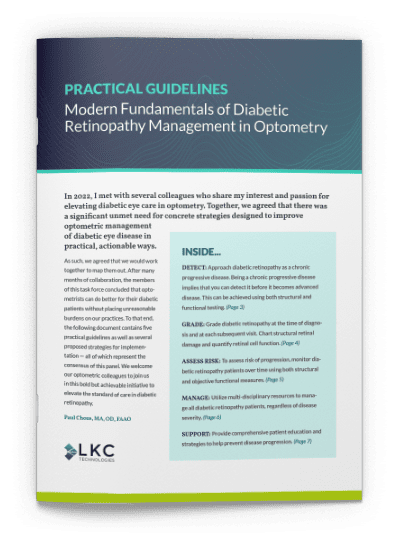

LKC Technologies, a leader in functional testing using electroretinography (ERG), has released a new report on diabetic retinopathy (DR). Modern Fundamentals of Diabetic Retinopathy Management in Optometry is a consensus document developed by an optometric task force comprised of medical optometry educators. This panel endeavored to simplify and standardize DR assessment and management to avoid preventable vision loss.
The group’s inaugural meeting was held in 2022 and was led by Paul Chous, MA, OD, FAAO, of Chous Eye Care Associates in Tacoma, Washington. At the first meeting, every member of the task force agreed that structure, although important, isn’t enough to comprehensively monitor patients who have diabetic eye disease. Rather, to properly stage DR and to safely assess risk of progression, both structural and functional measures are needed. Furthermore, the group concluded, subjective findings such as visual acuity are a poor surrogate for objective functional tests, such as ERG.
“There is a dire need for an elevated protocol to guide patient care in DR,” says Jeffry D. Gerson, OD, FAAO, of Grin Eye Care in Olathe, Kansas. “The sad reality is that the complexity of this disease and the subjectivity of many of our tests can lead to errors and vision loss.”
The members of the task force believe that optometrists can do better for patients who have diabetes, and they are responding to a need to make the diagnosis and management of DR easier to implement in a clinical setting.
“The group strove to develop recommendations that would be practical to implement,” says Dr. Chous. “Our goal was to elevate the standard of care with proper management and vigilance, even given the challenges posed by today’s busy healthcare environments.”
To that end, Modern Fundamentals of Diabetic Retinopathy Management in Optometry presents a framework that will radically simplify DR management so that optometrists can confidently care for the growing population of patients with diabetes. The guidelines are based on five pillars, all of which are backed by evidence-based science. Briefly, the five pillars are as follows:
- DETECT: Approach diabetic retinopathy as a chronic progressive disease. Being a chronic progressive disease implies that you can detect it before it becomes advanced disease. This can be achieved using both structural and functional testing.
- GRADE: Grade diabetic retinopathy at the time of diagnosis and at each subsequent visit. Chart structural retinal damage and quantify retinal cell function.
- ASSESS RISK: To assess risk of progression, monitor diabetic retinopathy patients over time using both structural and objective functional measures.
- MANAGE: Utilize multi-disciplinary resources to manage all diabetic retinopathy patients, regardless of disease severity.
- SUPPORT: Provide comprehensive patient education and strategies to help prevent disease progression.
Expanded details on each of the pillars is available at https://lkc.com/modern-fundamentals-of-dr/. Over the coming months, the task force will also be providing additional in-depth explanations and responding to FAQs in optometry’s print publications and at continuing education venues. To learn more about the task force and events and resources associated with these new guidelines, visit https://lkc.com/advisors/.



